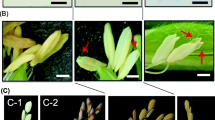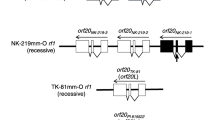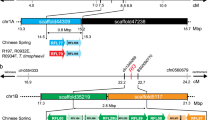Abstract
Gene expression associated with the restoration of fertility in sorghum lines carrying the IS1112C male-sterile cytoplasm was characterized through cDNA-AFLP transcript profiling and examinations of protein product abundance of selected mitochondrial genes. Microspores from near-isogenic male-sterile, fertility-restored, and normal-cytoplasm lines in two genetic backgrounds, and from four recombinant inbred lines (RILs) differing at two fertility restorer loci, were examined. We characterized seven transcript-derived fragments (TDFs) unique to a BC7F3 fertility-restored line, four of which were eliminated in a marker-selected BC11F3. Transcripts or cDNAs of the remaining three TDFs were detected in all lines examined, indicating that the unique fragments represent alleles detected by sequence polymorphisms or by enhanced transcript abundance. The TDFs were found to be derived from the non-recurrent IS1112C male parent, and certain of the TDFs may be linked to the fertility restorer alleles, consistent with analyses of the RILs. Sequences of the TDFs showed similarity with EST’s of unknown cellular function. The accumulation of mitochondrial proteins was examined in male-sterile, normal-cytoplasm, and restored BC11F3 lines. The male-sterile microspore mitochondria contained elevated levels of the nuclear-encoded alternative oxidase protein, potentially associating mitochondrial dysfunction with failed pollen development. The relative abundance of mitochondrial-encoded ATPA, ATP6 and COXII proteins, and of nuclear-encoded MnSOD, Cyt c and ALDH proteins, did not vary with cytoplasm or fertility status at the microspore stage.





Similar content being viewed by others
References
Allen J (2005) Effect of teosinte cytoplasmic genomes on maize phenotype. Genetics 169:863–880
Balk J, Leaver CJ (2001) The PET1-CMS mitochondrial mutation in sunflower is associated with premature programmed cell death and cytochrome c release. Plant Cell 13:1803–1818
Breyne P, Dreesen R. Vandepoele K, De Veylder L, Van Breusegem F, Callewaert L, Rombauts S, Raes J, Cannoot B, Engler G, Inze D, Zabeau M (2002) Transcriptome analysis during cell division in plants. Proc Natl Acad Sci USA 99:14825–14830
Breyne P, Dreesen R, Cannoot B, Rombaut D, Vandepoele K, Rombauts S, Vanderhaeghen R, Inze D, Zabeau M (2003) Quantitative cDNA-AFLP analysis for genome-wide expression studies. Mol Gen Genomics 269:173–179
Chase C, Gabay-Laughnan S (2004) Cytoplasmic male sterility and fertility restoration by nuclear genes. In: Daniell H, Chase CD (eds) Molecular biology, biotechnology of plant organelles. Springer, Dordrecht, pp 623–634
Datta R, Chourey PS, Pring DR, Tang HV (2001) Gene-expression analysis of sucrose-starch metabolism during pollen maturation in cytoplasmic male-sterile and fertile lines of sorghum. Sex Plant Reprod 14:127–134
Datta R, Chamusco KC, Chourey PS (2002) Starch biosynthesis during pollen maturation is associated with altered patterns of gene expression in maize. Plant Phys 130:1645–1656
Green DR, Kroemer G (2004) The pathophysiology of mitochondrial cell death. Science 305:626–629
Hanson MR, Bentolila S (2004) Interactions of mitochondrial and nuclear genes that affect male gametophyte development. Plant Cell 16:S154–S169
Honys D, Twell D (2004) Transcriptome analysis of haploid male gametophyte development in Arabidopsis. Genome Biol 5:R85
Hochholdinger F, Guo L, Schnable PS (2004) Cytoplasmic regulation of the accumulation of nuclear-encoded proteins in mitochondrial proteome of maize. Plant J 37:199–208
Jackson C, JE Dench DO Hall, Moore AL (1979) Separation of mitochondria from contaminating subcellular structures utilizing silica sol gradient centrifugation. Plant Physiol 64:150–153
Jones A (2000) Does the plant mitochondrion integrate cellular stress and regulate programmed cell death? Trends Plant Sci 5:225–230
Karpova OV, Kuzmin EV, Elthon TE, Newton KJ (2002) Differential expression of alternative oxidase genes in maize. Plant Cell 14:3271–3284
Kliebenstein DJ, Monde R-A, Last RL (1998) Superoxide dismutase in Arabidopsis: an eclectic enzyme family with disparate regulation and protein localization. Plant Physiol 118:637–650
Kuzmin EV, Karpova OV, Elthon TE, Newton KJ (2004) Mitochondrial respiratory deficiencies signal up-regulation of genes for heat shock proteins. J Biol Chem 279:20672–20677
Leuthy M, Horak A, Elthon TE (1993) Monoclonal antibodies to the α and β subunits of the plant mitochondrial F1 ATPase. Plant Physiol 101:931–937
Levings CSIII (1993) Thoughts on cytoplasmic male sterility in cms-T maize. Plant Cell 5:1285–1290
Liu F, Cui X, Horner HT, Weiner H, Schnable PS (2001) Mitochondrial aldehyde dehydrogenase activity is required for male fertility in maize. Plant Cell 13:1063–1078
Lu B, Hanson MR (1994) A single homogeneous form of ATP6 protein accumulates in petunia mitochondria despite the presence of differentially edited atp6 transcripts. Plant Cell 6:1955–1968
Maxwell DP, Nickels R, McIntosh L (2002) Evidence of mitochondrial involvement in the transduction of signals required for the induction of genes associated with pathogen attack and senescence. Plant J 29:269–279
McCormick S (1993) Male gametophyte development. Plant Cell 5:1265–1275
McCormick S (2004) Control of male gameotphyte development. Plant Cell 16:S142-S153
Mittler R (2002) Oxidative stress, antioxidants and stress tolerance. Trends Plant Sci 7:405–410
Mullet JE, Klein RR, Klein PE (2002) Sorghum bicolor—an important species for comparative grass genomics and a source of beneficial genes for agriculture. Curr Opin Plant Biol 5:118–121
Nivison HT, Sutton CA, Wilson RJ, Hanson MR (1994) Sequencing, processing, and localization of the petunia CMS-associated mitochondrial protein. Plant J 5:613–623
Pring DR, Tang HV, Chen W, Howad W, Kempken F (1999) A unique two-gene gametophytic male sterility system in sorghum involving a possible role of RNA editing in fertility restoration. J Hered 90:386–393
Pring DR, Tang HV (2001) Mitochondrial atp6 transcript editing during microgametogenesis in male-sterile sorghum. Curr Gen 39:371–376
Pring DR, Tang HV (2004) Transcript profiling of male-fertile and male-sterile sorghum indicates extensive alterations in gene expression during microgametogenesis. Sexual Plant Reprod 16:289–297
Sanchirico ME, Fox TD, Mason TL (1998) Accumulation of mitochondrially synthesized Saccharomyces cerevisiae Cox2p and Cox3p depends on targeting information in untranslated portions of their mRNAs. EMBO J 17:5796–5804
Tang HV, Pring DR, Shaw LC, Salazar SA, Muza FR, Yan B, Schertz KF (1996) Transcript processing internal to a mitochondrial open reading frame is correlated with fertility restoration in male-sterile sorghum. Plant J 10:123–133
Tang HV, Chang R, Pring DR (1998) Cosegregation of single genes associated with fertility restoration and transcript processing of sorghum mitochondrial orf107 and urf209. Genetics 150:383–391
Tang HV, Chen W, Pring DR (1999) Mitochondrial orf107 transcription, editing, and nucleolytic cleavage conferred by the gene Rf3 are expressed in sorghum pollen. Sex Plant Reprod 12:53–59
Tang HV, Pring DR (2003) Conversion of fertility restoration of the sorghum IS1112C (A3) male-sterile cytoplasm from two genes to one gene. Crop Sci 43:1747–1753
Wen L, Chase CD (1999a) Mitochondrial gene expression in developing male gametophytes of male-fertile and S male-sterile maize. Sex Plant Reprod 11:323–330
Wen L, Chase CD (1999b) Pleiotropic effects of a nuclear restorer-of-fertility locus on mitochondrial transcripts in male-fertile and S male-sterile maize. Curr Genet 35:521–526
Wen L, Tang HV, Chen W, Chang R, Pring DR, Klein PE, Childs KL, Klein RR (2002) Development and mapping of AFLP markers linked to the sorghum fertility restorer gene rf4. Theor Appl Genet 104:577–585
Yao N, Eisenfelder BJ, Marvin J, Greenberg JT (2004) The mitochondrion—an organelle commonly involved in programmed cell death in Arabidopsis thaliana. Plant J 40:596–610
Zabala G, Gabay-Laughnan S, Laughnan JR (1997) The nuclear gene Rf3 affects the expression of the mitochondrial chimeric sequence R implicated in S-type male sterility in maize. Genetics 147:847–860
Zubko MK (2004) Mitochondrial tuning fork in nuclear homeotic functions. Trends Plant Sci 9:61–64
Acknowledgments
We thank Drs. R. R. Klein, J. Rollins, and W. Y. Song for critical reviews, and acknowledge the technical assistance of Odenis Vitorelli. This was a cooperative investigation of the U.S. Department of Agriculture-Agricultural Research Service and the Institute of Food and Agricultural Sciences, University of Florida. Florida Agricultural Experiment Stations Journal Series R-10647.
Author information
Authors and Affiliations
Corresponding author
Additional information
Communicated by S. Russell
Rights and permissions
About this article
Cite this article
Pring, D.R., Tang, H.V., Chase, C.D. et al. Microspore gene expression associated with cytoplasmic male sterility and fertility restoration in sorghum. Sex Plant Reprod 19, 25–35 (2006). https://doi.org/10.1007/s00497-005-0019-8
Received:
Accepted:
Published:
Issue Date:
DOI: https://doi.org/10.1007/s00497-005-0019-8




